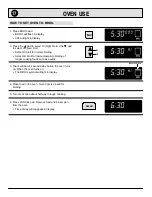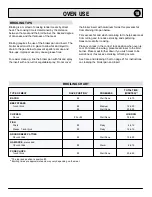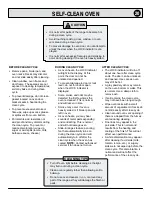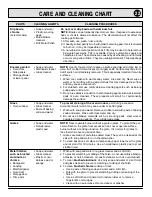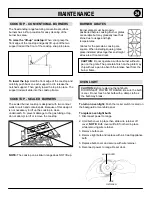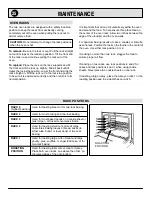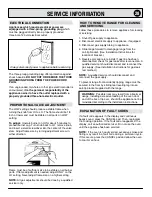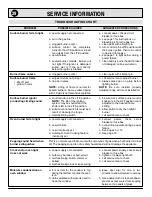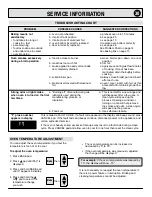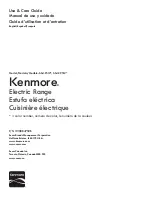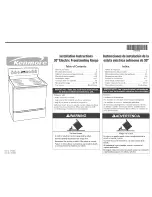
OVEN USE
15
ROASTING
Roasting is the method for cooking large, tender cuts of
meat uncovered, without adding moisture. Most meats are
roasted at 325
°
F. It is not necessary to preheat the oven.
Place the roasting pan on either of the two lowest rack
positions.
Use tender cuts of meat weighing three pounds or more.
Some good choices are: Beef rib, ribeye, top round, high
quality tip and rump roast, pork loin roast, leg of lamb,
veal shoulder roast and cured or smoked hams.
Season meat, if desired, either before or after roasting.
Rub into the surface of the roast if added before cooking.
Place the meat fat-side-up on a rack in a shallow roasting
pan. Placing the meat on a rack holds it out of the
drippings, thus allowing better heat circulation for even
cooking. As the fat on top of the roast melts, the meat is
basted naturally, eliminating the need for additional
basting.
The cooking time is determined by the weight of the meat
and the desired doneness. For more accurate results, use
a meat thermometer. Insert it so the tip is in the center of
the thickest part of the meat. It should not touch fat or
bone.
Remove the roast from the oven when the thermometer
registers the desired internal temperature.
NOTE:
For more information about food safety, call
USDA’s Meat & Poultry Hotline at 1-800-535-4555. For
cooking information call or write to the National Cattle-
men’s Beef Association, 444 North Michigan Avenue,
Chicago, Illinois 60611, or call 1-800-368-3138.
Approximate
Oven
Approximate*
Weight
Temperature
Internal
Roasting Time
Cut of Meat
(pounds)
in
°
F
Temperature
(min. per lb.)
Beef
Rib Roast (cut-side-down)
4 to 8
325
°
F
145
°
F (medium/rare)
25 - 35
160
°
F (medium)
30 - 35
Rib Eye Roast
4 to 6
350
°
F
145
°
F (medium/rare)
25 - 35
160
°
F (medium)
30 - 35
Loin Tenderloin Roast
2 to 3
400
°
F
145
°
F (medium/rare)
20 - 30
Pork, Fresh
Shoulder Blade Roast, (boneless)
4 to 6
325
°
F
160
°
F
35 - 45
Shoulder Blade Roast
4 to 6
325
°
F
160
°
F
30 - 40
Loin Blade or Sirloin Roast
3 to 4
325
°
F
160
°
F
35 - 40
Boneless Pork Loin
6 to 8
325
°
F
160
°
F
25 - 35
Pork, Smoked
Ham, Half (fully cooked)**
5 to 7
325
°
F
140
°
F
25 - 35
Ham, Half (cook-before-eating)
5 to 7
325
°
F
140
°
F
35 - 45
Poultry
Turkey, unstuffed***
12 to 16
325
°
F
180
°
-185
°
F
18 - 20
16 to 20
325
°
F
180
°
-185
°
F
16 - 18
20 to 24
325
°
F
180
°
-185
°
F
14 - 16
Turkey, Breast
3 to 8
325
°
F
180
°
F
30 - 40
Chicken, Fryer
2 1/2 to 3 1/2
350-375
°
180
°
F
20 - 25
Chicken, Roaster
4 to 6
350-375
°
F
180
°
F
20 - 25
Lamb
Leg (boneless)
2 to 3
325
°
F
160
°
F
35 - 40
170
°
F
40 - 45
Whole Leg
5 to 7
325
°
F
160
°
F
30 - 35
* Cooking times are approximate and may vary depending on the shape of the roast. A meat thermometer is the most accurate way
to determine doneness.
** Add water and follow package directions.
*** Stuffed turkey requires additional roasting time. Shield legs and breast with foil to prevent overbrowning and drying of skin.
ROASTING CHART
(Thawed meats only)

















